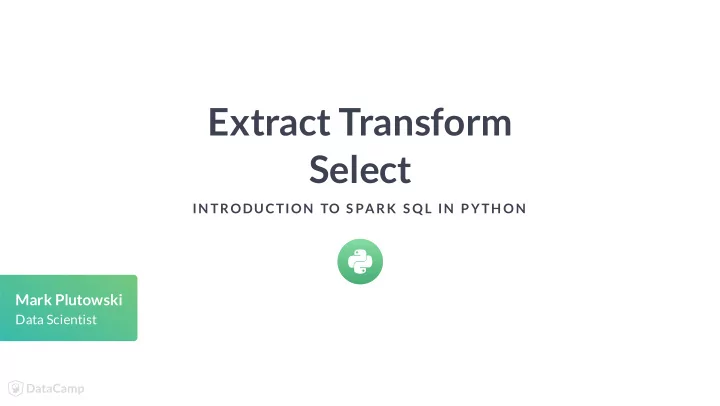

Extract Transform Select IN TRODUCTION TO S PARK S QL IN P YTH ON Mark Plutowski Data Scientist
INTRODUCTION TO SPARK SQL IN PYTHON
INTRODUCTION TO SPARK SQL IN PYTHON
Extract, Transform, and Select Extraction Transformation Selection INTRODUCTION TO SPARK SQL IN PYTHON
Built-in functions from pyspark.sql.functions import split, explode INTRODUCTION TO SPARK SQL IN PYTHON
The length function from pyspark.sql.functions import length df.where(length('sentence') == 0) INTRODUCTION TO SPARK SQL IN PYTHON
Creating a custom function User De�ned Function UDF INTRODUCTION TO SPARK SQL IN PYTHON
Importing the udf function from pyspark.sql.functions import udf INTRODUCTION TO SPARK SQL IN PYTHON
Creating a boolean UDF print(df) DataFrame[textdata: string] from pyspark.sql.functions import udf from pyspark.sql.types import BooleanType INTRODUCTION TO SPARK SQL IN PYTHON
Creating a boolean UDF short_udf = udf(lambda x: True if not x or len(x) < 10 else False, BooleanType()) df.select(short_udf('textdata')\ .alias("is short"))\ .show(3) +--------+ |is short| +--------+ | false| | true| | false| +--------+ INTRODUCTION TO SPARK SQL IN PYTHON
Important UDF return types from pyspark.sql.types import StringType, IntegerType, FloatType, ArrayType INTRODUCTION TO SPARK SQL IN PYTHON
Creating an array UDF df3.select('word array', in_udf('word array').alias('without endword'))\ .show(5, truncate=30) +-----------------------------+----------------------+ | word array| without endword| +-----------------------------+----------------------+ |[then, how, many, are, there]|[then, how, many, are]| | [how, many]| [how]| | [i, donot, know]| [i, donot]| | [quite, so]| [quite]| | [you, have, not, observed]| [you, have, not]| +-----------------------------+----------------------+ INTRODUCTION TO SPARK SQL IN PYTHON
Creating an array UDF from pyspark.sql.types import StringType, ArrayType # Removes last item in array in_udf = udf(lambda x: x[0:len(x)-1] if x and len(x) > 1 else [], ArrayType(StringType())) INTRODUCTION TO SPARK SQL IN PYTHON
Sparse vector format 1. Indices 2. Values Example: Array: [1.0, 0.0, 0.0, 3.0] Sparse vector: (4, [0, 3], [1.0, 3.0]) INTRODUCTION TO SPARK SQL IN PYTHON
Working with vector data hasattr(x, "toArray") x.numNonzeros()) INTRODUCTION TO SPARK SQL IN PYTHON
Let's practice! IN TRODUCTION TO S PARK S QL IN P YTH ON
Creating feature data for classi�cation IN TRODUCTION TO S PARK S QL IN P YTH ON Mark Plutowski Data Scientist
Transforming a dense array from pyspark.sql.functions import udf from pyspark.sql.types import IntegerType bad_udf = udf(lambda x: x.indices[0] if (x and hasattr(x, "toArray") and x.numNonzeros()) else 0, IntegerType()) INTRODUCTION TO SPARK SQL IN PYTHON
Transforming a dense array try: df.select(bad_udf('outvec').alias('label')).first() except Exception as e: print(e.__class__) print(e.errmsg) <class 'py4j.protocol.Py4JJavaError'> An error occurred while calling o90.collectToPython. INTRODUCTION TO SPARK SQL IN PYTHON
UDF return type must be properly cast first_udf = udf(lambda x: int(x.indices[0]) if (x and hasattr(x, "toArray") and x.numNonzeros()) else 0, IntegerType()) INTRODUCTION TO SPARK SQL IN PYTHON
The UDF in action +-------+--------------------+-----+--------------------+-------------------+ |endword| doc|count| features| outvec| +-------+--------------------+-----+--------------------+-------------------+ | it|[please, do, not,...| 1149|(12847,[15,47,502...| (12847,[7],[1.0])| | holmes|[start, of, the, ...| 107|(12847,[0,3,183,1...|(12847,[145],[1.0])| | i|[the, adventures,...| 103|(12847,[0,3,35,14...| (12847,[11],[1.0])| +-------+--------------------+-----+--------------------+-------------------+ df.withColumn('label', k_udf('outvec')).drop('outvec').show(3) +-------+--------------------+-----+--------------------+-----+ |endword| doc|count| features|label| +-------+--------------------+-----+--------------------+-----+ | it|[please, do, not,...| 1149|(12847,[15,47,502...| 7| | holmes|[start, of, the, ...| 107|(12847,[0,3,183,1...| 145| | i|[the, adventures,...| 103|(12847,[0,3,35,14...| 11| +-------+--------------------+-----+--------------------+-----+ INTRODUCTION TO SPARK SQL IN PYTHON
CountVectorizer ETS : Extract Transform Select CountVectorizer is a Feature Extractor Its input is an array of strings Its output is a vector INTRODUCTION TO SPARK SQL IN PYTHON
Fitting the CountVectorizer from pyspark.ml.feature import CountVectorizer cv = CountVectorizer(inputCol='words', outputCol="features") model = cv.fit(df) result = model.transform(df) print(result) DataFrame[words: array<string>, features: vector] # Dense string array on left, dense integer vector on right +-------------------------+--------------------------------------+ |words |features | +-------------------------+--------------------------------------+ |[Hello, world] |(10,[7,9],[1.0,1.0]) | |[How, are, you?] |(10,[1,3,4],[1.0,1.0,1.0]) | |[I, am, fine, thank, you]|(10,[0,2,5,6,8],[1.0,1.0,1.0,1.0,1.0])| +-------------------------+--------------------------------------+ INTRODUCTION TO SPARK SQL IN PYTHON
Let's practice! IN TRODUCTION TO S PARK S QL IN P YTH ON
Text Classi�cation IN TRODUCTION TO S PARK S QL IN P YTH ON Mark Plutowski Data Scientist
INTRODUCTION TO SPARK SQL IN PYTHON
INTRODUCTION TO SPARK SQL IN PYTHON
INTRODUCTION TO SPARK SQL IN PYTHON
INTRODUCTION TO SPARK SQL IN PYTHON
INTRODUCTION TO SPARK SQL IN PYTHON
INTRODUCTION TO SPARK SQL IN PYTHON
INTRODUCTION TO SPARK SQL IN PYTHON
INTRODUCTION TO SPARK SQL IN PYTHON
Selecting the data df_true = df.where("endword in ('she', 'he', 'hers', 'his', 'her', 'him')")\ .withColumn('label', lit(1)) df_false = df.where("endword not in ('she', 'he', 'hers', 'his', 'her', 'him')")\ .withColumn('label', lit(0)) INTRODUCTION TO SPARK SQL IN PYTHON
Combining the positive and negative data df_examples = df_true.union(df_false) INTRODUCTION TO SPARK SQL IN PYTHON
Splitting the data into training and evaluation sets df_train, df_eval = df_examples.randomSplit((0.60, 0.40), 42) INTRODUCTION TO SPARK SQL IN PYTHON
Training from pyspark.ml.classification import LogisticRegression logistic = LogisticRegression(maxIter=50, regParam=0.6, elasticNetParam=0.3) model = logistic.fit(df_train) print("Training iterations: ", model.summary.totalIterations) INTRODUCTION TO SPARK SQL IN PYTHON
Let's practice! IN TRODUCTION TO S PARK S QL IN P YTH ON
Predicting and evaluating IN TRODUCTION TO S PARK S QL IN P YTH ON Mark Plutowski Data Scientist
Applying a model to evaluation data predicted = df_trained.transform(df_test) prediction column: double probability column: vector of length two x = predicted.first print("Right!" if x.label == int(x.prediction) else "Wrong") INTRODUCTION TO SPARK SQL IN PYTHON
Evaluating classi�cation accuracy model_stats = model.evaluate(df_eval) type(model_stats) pyspark.ml.classification.BinaryLogisticRegressionSummary) print("\nAccuracy: %.2f" % model_stats.areaUnderROC) INTRODUCTION TO SPARK SQL IN PYTHON
Example of classifying text Positive labels: [ 'her', 'him', 'he', 'she', 'them', 'us', 'they', 'himself', 'herself', 'we' ] Number of examples: 5746 Number of examples: 2873 positive , 2873 negative Number of training examples: 4607 Number of test examples: 1139 training iterations: 21 T est AUC: 0.87 INTRODUCTION TO SPARK SQL IN PYTHON
Predicting the endword Positive label: 'it' Number of examples: 438 Number of examples: 219 positive , 219 negative Number of training examples: 340 Number of test examples: 98 T est AUC: 0.85 INTRODUCTION TO SPARK SQL IN PYTHON
Let's practice! IN TRODUCTION TO S PARK S QL IN P YTH ON
Recap IN TRODUCTION TO S PARK S QL IN P YTH ON Mark Plutowski Data Scientist
Recap Window function SQL E xtract T ransform S elect Train Predict Evaluate INTRODUCTION TO SPARK SQL IN PYTHON
Congratulations! IN TRODUCTION TO S PARK S QL IN P YTH ON
Recommend
More recommend